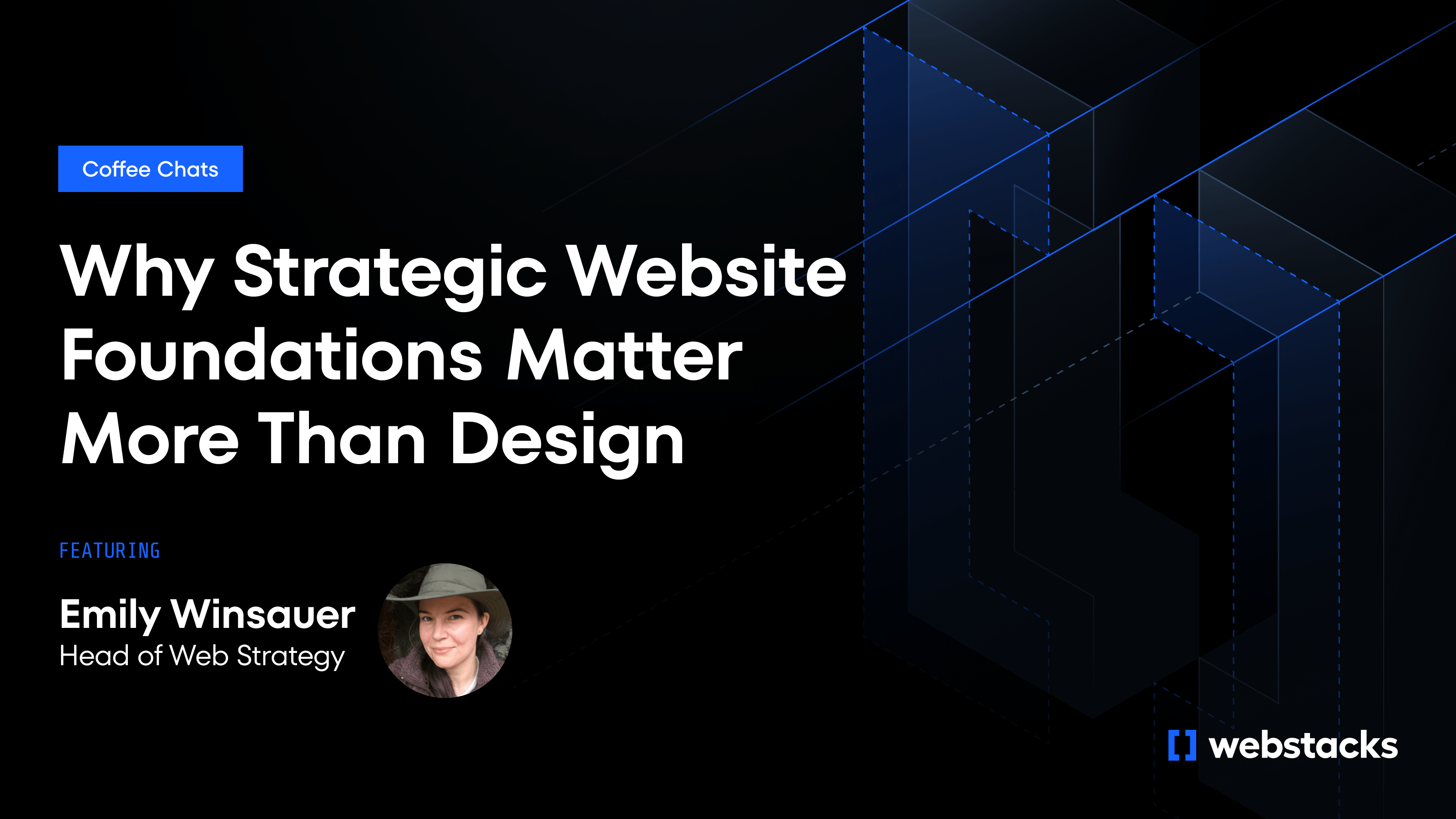Early-stage websites are built for speed, not scale. They help validate demand and ship fast, but the same shortcuts—lean architecture, limited CMS flexibility, and minimal governance—start to break down as your team grows.
The question isn't whether you'll need to upgrade, but when. Waiting too long costs revenue through missed opportunities and operational inefficiencies. Moving too early wastes resources on premature optimization. The key is recognizing when your MVP site shifts from growth enabler to growth bottleneck.
This transition happens predictably across three impact levels: revenue performance, operational efficiency, and strategic scalability. Understanding these progression patterns helps you time your upgrade to maximize business impact while minimizing disruption.

Revenue Impact: When Site Performance Directly Affects Growth
Revenue-impacting issues demand immediate attention because they compound daily. These problems manifest in metrics that directly correlate with business outcomes and become more expensive to ignore over time.
Performance and SEO Degradation
Code optimized for speed-to-launch often creates long-term drag. Inline styles, unoptimized images, and dozens of third-party scripts push time to first byte and Largest Contentful Paint beyond Google's thresholds. This leads to lower rankings, higher bounce rates, and slower conversions, especially on mobile.
When organic traffic drops by 15% or more month-over-month, or when Core Web Vitals consistently fail Google's thresholds, paid campaigns end up doing double duty, covering for traffic that organic search used to drive. User trust erodes with every delay, creating a compounding effect on conversion rates.
Rebuilding on a performance-first framework like Next.js or Astro, paired with an API-driven CMS, helps clean up the mess. You reduce JavaScript payloads, improve load times, and unlock faster deployments. This shift enhances Core Web Vitals across the board, providing your site with the speed, structure, and scalability necessary for sustained growth.
Conversion Rate Plateaus Despite Traffic Growth
If traffic is growing but conversions remain flat for three consecutive months, the problem usually isn't the campaign—it's the site experience. Friction often hides in slow-loading pages, unclear value propositions, or poorly positioned CTAs. Basic A/B tools limit testing to surface-level changes like button color or headlines, which rarely move the needle on meaningful metrics.
Most teams over-index on top-line traffic while ignoring deeper metrics like form completion rates, time-to-conversion, or post-click engagement. These metrics surface where the current site architecture is underperforming and where conversion gaps are costing real revenue. For SaaS companies, the longer you delay fixing these bottlenecks, the more they compound across your funnel.
To run meaningful experiments, you need a system built for iteration. That includes a headless CMS like Contentful or visual tools like Storyblok, structured content that supports dynamic personalization, and reusable components that marketing can adjust without engineering help. This setup lets you test multiple CTA variants, audience-specific messaging, or layout adjustments in parallel.
Operational Impact: When Workflow Inefficiencies Slow Growth
Operational issues affect team productivity and campaign velocity. While less immediately visible than revenue problems, they create cascading delays that ultimately impact growth trajectory and team morale.
Marketing Velocity Constraints
Growth-stage marketing teams need to move fast, spinning up campaign pages, testing new headlines, and localizing content for different segments. When every content update requires developer involvement, even basic changes can stall for days or weeks.
MVP sites often lack reusable components, version control, and staging environments, making iteration slow and risky. Without a modular system or clear governance, what should be a 30-minute update turns into a multi-day bottleneck.
The result is measurable: ad spend goes live without tailored landing pages, experiments never reach statistical significance, and revenue opportunities slip through the cracks. When marketing requests consistently take more than 48 hours to implement, or when campaign launches are delayed by site limitations more than twice per month, site architecture is limiting marketing effectiveness.
Stakeholder Workflow Breakdown
As marketing, product, sales, and legal teams get involved in content management, a lack of structure starts to create risk. Without role-based permissions, anyone can make changes. Without branch previews, even small edits feel dangerous.
Review cycles become chaotic when feedback comes through Slack messages, emails, and annotated screenshots. Final approval often happens at the last minute, with changes that were never reviewed in context. This creates a cycle where urgent fixes bypass proper review, leading to inconsistencies and errors.
A structured workflow solves this through role-specific access controls that limit who can publish, edit, or comment. Preview environments let stakeholders see changes in a live context before launch, while version history and content staging help catch issues before they reach production.
Strategic Impact: When Architecture Limits Future Growth
Strategic issues affect your ability to execute advanced growth strategies and respond to market opportunities. These problems often develop gradually but eventually constrain your competitive position.
Brand Evolution Constraints
As your positioning matures, especially after a funding round, rebrand, or new marketing leadership, the MVP site starts to fall short. It no longer reflects the depth of your product, the strength of your message, or the expectations of your audience. You might have new messaging, visuals, and content priorities, but no structured way to roll them out consistently.
Rigid templates and unorganized design files force designers into manual fixes, leading to inconsistencies across pages. Without a component library or design system, updating messaging, CTAs, or visuals requires touching multiple files and increases the risk of errors.
A modular system with a shared component library addresses this issue by allowing you to update messaging, CTAs, or visuals once and apply the changes across the entire site without rework. This transforms your site into a flexible system that keeps pace with your brand's evolution over time.
Advanced Growth Strategy Limitations
Modern growth strategies like account-based marketing, dynamic pricing, and product-led onboarding rely on real-time data integration. But most MVP sites are held together by hard-coded templates and plugins that don't integrate cleanly with your CDP, CRM, or data warehouse.
Personalization efforts stall when there's no way to sync audience segments with live content. Teams end up exporting CSVs and creating static variations manually, which slows down launches and limits testing. Without a flexible architecture, every personalization idea turns into a development dependency.
An API-first, composable stack changes that by allowing you to connect segmentation data to live modules, adjust content based on firmographics or behavior, and track outcomes in real time. You can tailor hero headlines, CTAs, or onboarding flows based on who is visiting and what they've done, without waiting weeks to ship. This is what makes personalization scalable—without it, your best ideas stay in the backlog while faster-moving competitors test, learn, and iterate.

Planning Your Strategic Upgrade
Treat your website upgrade like a product initiative. Move fast, but stay grounded in business impact. A systematic approach keeps scope focused and momentum high while addressing the most critical issues first.
Assessment and Prioritization Framework
Before jumping into a redesign, conduct a systematic evaluation of your current site's limitations. This assessment helps you understand which impact level you're experiencing and ensures your upgrade addresses the most critical business needs first. Use this framework to build a data-driven case for your redesign and avoid scope creep during implementation.
- Revenue Impact Assessment: Audit current performance metrics against industry benchmarks. Document specific gaps in conversion rates, page speed, and SEO performance. Quantify the revenue impact of each issue to establish upgrade urgency.
- Operational Efficiency Review: Map current content workflows and identify bottlenecks. Track time-to-publish for different content types and note how often marketing requests are delayed by technical constraints.
- Strategic Capability Audit: Evaluate your ability to execute advanced growth strategies. Assess integration capabilities, personalization potential, and scalability constraints that might limit future initiatives.
Phased Implementation Strategy
Once you've identified your priority issues, resist the urge to tackle everything at once. A phased approach reduces risk, delivers value incrementally, and allows you to validate solutions before committing to larger changes. This strategy keeps your current site functional while building momentum through early wins that justify continued investment.
- Phase 1 - Foundation: Address revenue-impacting issues first. Implement performance optimizations, fix critical SEO problems, and establish basic workflow improvements. This phase should show measurable business impact within 30-60 days.
- Phase 2 - Operations: Streamline content management and stakeholder workflows. Implement proper staging environments, role-based permissions, and structured review processes. Focus on reducing time-to-publish and improving content quality.
- Phase 3 - Strategic: Build advanced capabilities for personalization, integration, and scalability. This phase enables new growth strategies and competitive advantages but should only begin after operational foundations are solid.
Stakeholder Alignment and Risk Mitigation
Loop in stakeholders early through structured workshops that align on dependencies and success metrics. Publish a living roadmap with clear status indicators to cut side-channel noise and keep everyone aligned on progress.
Use a composable architecture approach to minimize risk. Legacy content stays live while new systems roll out in parallel, allowing for testing and validation before full migration. This approach avoids risky, all-at-once launches while giving your team working software every sprint.
Turn Your Site Into Growth Infrastructure
Your website isn't a static brochure—it's the infrastructure powering every campaign, demo request, and renewal. When metrics like rising bounce rates or sluggish page speed signal friction, delaying an upgrade stunts the revenue growth you've already validated through your MVP phase.
The key is recognizing which impact level you're experiencing and responding proportionally. Revenue issues demand immediate action, operational constraints require systematic workflow improvements, and strategic limitations need architectural solutions.
Webstacks turns that inflection point into momentum. We build composable, headless architectures tailored to B2B SaaS, so marketing can spin up pages, tests, and integrations without waiting on engineering. That means faster iterations, cleaner governance, and performance that scales alongside Series A, B, and C milestones. Ready to turn your site into growth infrastructure? Book a call with our team to map a phased upgrade strategy that accelerates pipeline instead of blocking it.




